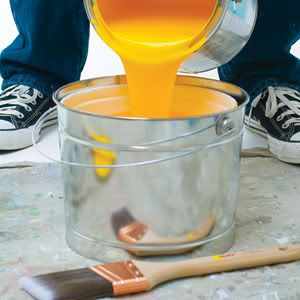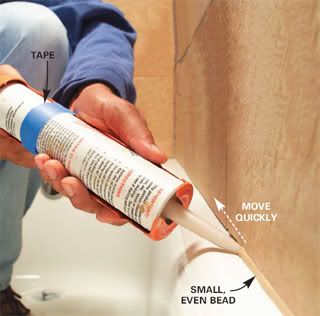Need to Know Home Improvement Tips
Finding a decent contractor can be a difficult and frustrating process. When money is tight, nothing is more infuriating than not getting what you paid for. There is an option, though, to make sure your home improvement projects are done exactly the way you want; complete them yourself. Building codes will require certain work, if you want to be legal, do be done by licensed professionals, but there are many projects you are probably more than capable to handle this weekend. Put a little cash in your vacation fund and impress your old lady with these 7 improvement projects you can cross off the list without calling in the high priced guys.
Painting
Very visible and very cheap. Adding a bit of color to a wall or room can completely change the area’s feel. Look around your home, are the walls lacking diversity? A few cans of paint and an afternoon will change your home’s color profile, making it feel warmer, brighter, or more luxurious. A dark, rich color, for example, will add drama and elegance to a room, a nice choice for your theater room. The key to a nice paint job is preparation. Take care to fix all imperfections in your walls, remove fixtures and furniture and cover everything else. This will make for a quick, clean and uneventful afternoon of painting.
Caulking
The DIY Network says that caulking, or lack there of, is the leading cause of shower and tub leaks. Old, peeling caulk also gives your shower a real dingy appearance, not something you want to subject guests to. Fixing this issue, though, is real easy. First remove all the old caulk before and clean the area well. DIY Network recommends a caulk with built-in mildew killer and using a caulking gun (cheap) for ease of application. On a completely dry surface, apply a thin bead of caulking and smooth with a moistened finger to make sure there are no air pockets. Now your bathroom is mother-in-law approved.
Tile
Upgrading a bathroom, laundry room or kitchen to tile flooring can really improve the room’s value and add luxury to your home. First, clear the floor of any old material, as well as the baseboards. Measure the square feet of the area so you know how much tile you’ll need. Mix your adhesive, and begin in the center of the room, laying one tile at a time. This will ensure even coverage and is especially important if your tiles are forming a design. Use spacers to create a consistent layout. To finish, fill the spaces with grout by putting down a big clump of it and dragging into the troughs. Remember to wipe the excess, always a good rule.
Leaky faucet
Drip, drip, drip in the middle of the night is an amazingly annoying sound. Go to your sink, and locate the leak. If it is coming from the faucet, it is probably a worn or failed washer. Turn off the water and remove and the faucet handle, which is likely held on by a couple screws. The handle protects the packing nut, which will have to be removed with pliers or an adjustable wrench. Now you are inside the faucet and should see a rubber washer (take care to note how everything goes back together). Remove it (likely held in place with a screw) and replace with an exact sized washer
.
Lawn care
Some parts of the home require constant maintenance or improvement, your lawn being an obvious offender. That monthly bill you are paying a lawn service company really adds up over the course of a year. HGTV has a few basic recommendations for doing the work yourself, but making it look like you have plenty of discretionary income for such things. First, don’t mow it too low; you’ll hurt the roots and promote dry and burned grass. You can get away with watering once a week, but make sure you give it a real solid soak, or a deep watering. Finally, feed your lawn some fertilizer 3 times a year with a nutrient filled product, complete with nitrogen, phosphate, potassium, copper, iron, and sulfur. Just like you, your lawn needs a healthy, well rounded diet.
Front door
Your front door is your guests’ gateway into the house and a nice one can set the mood for the visit. It can also add security and energy efficiency. There are a lot of options out there, so to narrow down your choices, Bob Vila says to first consider these factors – climate, construction, maintenance and style. You want your door to match the look of your home and stand up to the elements. After choosing a door, be a man and install it yourself. Save yourself some trouble and order the door “pre-hung” meaning the hardware is already installed. Remove your old door by knocking out the hinge pins, unscrewing the old hinges and prying off the trim. In place of the previous door, slide in the new one. You may have to shim the new jambs. Check for plumb on the sides and the top for level. If everything is set, nail the jamb to the frame. Finally, install new trim material around the door. Now you have an entrance you can be proud of.

Demolition
You may get to a point where your home improvement project is too much to handle and you have to call in a professional. If any demolition is required, you can save your self some cash and do it yourself. No reason to be paying a plumber $150/hour to cut concrete. Our buddy Bob Vila doesn’t want you rushing into anything, though, so he provides some prep work before demo. First, get approval from the city for your project. When you are ready to begin the fun stuff (moving walls with heavy fire power) make sure the area you are working in is off – water, gas, electrical, etc. Have a solid understanding of the structural properties of whatever you are working on, like load bearing walls or beams, for example. Finally, you will have some waste from you demo, so make a plan to get rid of it. Know the rules for disposing of various materials, especially the hazardous types. Try not to get away while you’re swingin’.























